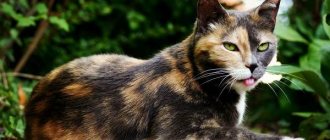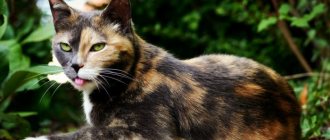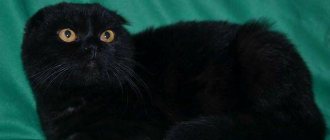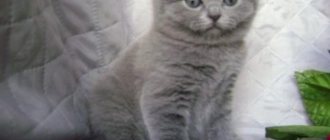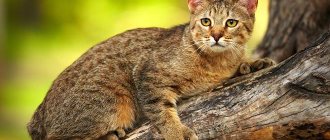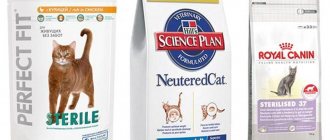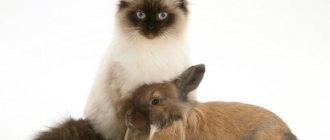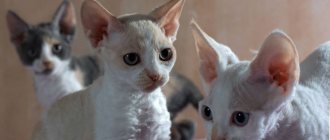Today you won’t surprise anyone with genetically modified plants and animals - neither in the laboratory, nor in the field, nor on the market. All that remains is to start breeding them at home - and some biohackers are already selling kits for genetic editing and promising to teach it to everyone. If you decide to practice on cats, we have compiled a guide for aspiring genetic engineers on how to assemble a cat with the coloring of your dreams.
Skin and hair color in cats (as in humans and other mammals) depends on the type of melanin
, which is produced by special skin cells, melanocytes - and then transported along their long processes to other cells and hair follicles, coloring them.
Two types of pigment are responsible for all the variety of colors that cats are known for:
- pheomelanin - it ranges from red to yellow;
- eumelanin - brown to black.
But what kind of pigments melanocytes will produce and how they will be distributed throughout the cat’s body are already responsible for many genes that can act in parallel, enhance each other’s work, or, conversely, compete. Let's look at the basic color patterns in cats and find out what gene variants will need to be introduced into the cat's genome to create them.
What are genes?
A gene is a small piece of DNA located on thread-like structures called chromosomes, which are made of DNA and come in matching pairs, one from the mother and one from the father. Chromosomes are present in every cell of the body. Each gene has a fixed location (loci) on the chromosome that helps determine a specific trait, such as fur length, eye color, and hair color.
Each location may contain different genes, and there is no fixed limit on the number of alternative genes that can occupy a locus. But each cat will only have two genes at a time.
© shutterstock
“Solid” and “patterned” cats
Red, black, even “tortoiseshell” coloring is definitely not enough to explain the endless variety of colors of cats. This is because cats can be uniformly colored or have a pattern (for example, circles or stripes).
Uniform (solid) cat colors are called solid, and colors with patterns are called tabby (or tabby).
With a solid color, the animal's fur has the same tone over the entire surface of the body, and the hairs are colored equally and evenly along the entire length.
Photo gallery: uniform (solid) cat colors
Black Bombay is a cat with perfectly black fur, without the slightest hint of spots or individual undyed hairs.
The chocolate exotic has a dark brown uniform coat tone.
In the lilac color of the British dog, blue and pink are intertwined
The pattern, called tabby, occurs due to the fact that in the darker areas of the animal's fur there is a greater amount of eumelanin (the pigment responsible for the black color) than in the lighter areas.
It is believed that it is tabby that is inherent in cats initially, that this is their natural “wild” color. Animals with this color are characterized by thinly outlined eyes and the presence of the letter “M” (or “scarab”) on the forehead. In addition, their cheekbones are emphasized by smooth descending lines.
A wild-colored Egyptian Mau cat has thin lines around the eyes and emphasized cheekbones, and on the forehead there is a characteristic “scarab” pattern (the letter “M”)
By the way, red (ginger) and cream cats are always “patterned”, it’s just that sometimes their pattern is barely distinguishable.
There are several main varieties of cat tabby pattern:
- tabby mackerel - striped “tiger” color, pattern in the form of parallel vertical stripes;
- classic tabby, marbled tabby - a color with wide spiral stripes on the sides, reminiscent of marble stains, with three stripes along the ridge, a spotted belly, stripes in the form of rings on the tail and paws;
- spotted tabby - a color with evenly spaced small spots throughout the body; spots may appear in the form of intermittent stripes.
Photo gallery: main types of tabby pattern
Striped tabby or mackerel tabby - a pattern of parallel vertical stripes on the cat's body Marbled or classic tabby - a pattern with wide spiral stripes on the sides of the cat Spotted tabby - a pattern with small spots or intermittent stripes throughout the cat's body
But if initially all cats have a pattern (tabby), where do animals with a solid color come from?
Why does a cat need ticking?
The fact is that a tabby on a cat's fur coat appears only when each hair on the animal is divided into zones with different color intensities, that is, painted with stripes. This is the so-called agouti effect (or ticking), which is also determined by the mechanism of heredity.
With zoned coloring of cat hair (agouti effect), one or more darker stripes are located on a light background
It is the differently colored hairs that form the pattern on the animal’s fur coat. If there is no agouti effect, and each hair in the fur has an even tone along its entire length, then the cat’s color will be solid.
There is a separate type of tabby cat pattern, when on a light background of each hair there are two or three horizontal dark stripes, and all hairs are colored the same. This pattern is called ticked (Abyssinian) tabby. In this case, the animal has no stripes or spots on the body, although the characteristic pattern on the muzzle and partially on the paws and tail are preserved; the fur seems to be strewn with small, small freckles and looks shimmering. This color is typical for Abyssinian cats.
The wild-colored Abyssinian cat has no spots or stripes on the body, but retains the characteristic tabby pattern on the face (eyes outlined in thin lines and a scarab mark on the forehead)
Ticking of cat fur has several options and manifests itself in the color of the animal with different effects: from light “shadedness” (when the very tip of the hair is colored) to deep “smokiness” (when the hair is colored almost the entire length).
Photo gallery: options for displaying the agouti effect (zoned dyeing) on a hair of cat hair
Hair with ticked shaded color Hair with shaded color Hair with shaded red (cameo) color Hair with smoky color
If we talk about shaded colors, they are very much appreciated by lovers of the British and Persian breeds. The idea here is that each hair is dyed only by a third (approximately), and the remaining part is significantly lighter than the dyed area. As a result, it seems that a translucent veil is draped over the animal.
British woman with shaded color, as if covered with a translucent veil
Thus, the base color (black or red) + tabby + presence/absence of ticking and its variety = the whole variety of cat colors (with some exceptions, which we will talk about later).
Two primary colors
Cats come in a huge variety of coat colors, but there are only two pigments that determine coat color. Eumelanin (black) and pheomelanin (red). White is omitted because it is not a color, but the absence of color.
Any other coat color is a variation of these two pigments due to genetic mutations or modifier genes.
- Dilution : changes black to blue and red to cream, chocolate to lilac.
- Dilution Modifier : The dilution modifier changes dilution colors from blue to taupe, lilac to caramel, cream to apricot.
- White spotting gene : This creates white patches in tabby cats and can range from a few hairs to almost the entire coat. So if you ever see a cat that is a mix of solid or tabby and white (no matter how big or small), the cat carries the white spotting gene. The genome responsible for white spotting in the domestic cat has not yet been determined. Cats with large white spots typically have two copies of the white spot gene.
- Dominant White : This dominant gene masks all other colors, regardless of which color genes are present.
- Albino : complete lack of pigmentation in hair, skin and eyes due to a mutation in the gene encoding tyrosinase. Tyrosine is necessary for the production of melanin, the main pigment of the skin and hair of cats; it gives us wonderful colors.
- Partial albino : This unusual coat pattern is most often found in Siamese cats, and other spiky cats have a defective form of tyrosine that does not function at normal body temperature. Genetically, the Seal Point Siamese is a black cat, but due to a tyrosine defect, pigmentation may only appear on cooler areas of the body such as the nose, ears, feet and tail.
Cat breeds with different eyes
There are several snow-white breeds that often give birth to kittens with different eyes.
Turkish van
The breed got its name from the Van district in Turkey. Cats of this family are active and cheerful. They love contact with people, quickly get used to the family and then do not get off their hands.
In addition to the pure white color, the Turkish Van can be tortoiseshell. There is wool interspersed with red, black and gray, as well as brown shades. As a rule, the eyes are different, most often yellow and blue.
Turkish Vans often have individuals with heterochromia
Cats have very soft fur that is pleasant to the touch. Turkish Vans have good jumping abilities. “Taking” the mezzanine from its place is a piece of cake. These cats, like no other, love to bathe and swim, and are easy to train. Commands such as “sit” and “lie down” are mastered no worse than dogs. It is very easy to teach them to fetch a ball or give a paw.
Turkish Angora
The Turkish Angora is another breed with white fur and multi-colored eyes. Although there are representatives with a marbled coat, black and cream. The breed got its name in honor of the city of Angora, located in Byzantium, from where it was brought to Europe. The weight of an adult cat is only 3–4 kg. She has an elegant physique, developed muscles and a stable immune system.
The Turkish Angora is distinguished by fluffy, soft fur and an almost complete absence of undercoat. Like other representatives of odd-eyed cats, the ear on the side of the blue eye is predisposed to deafness. A hearing defect can be compensated by devotion to only one person, peacefulness and tolerant attitude towards other pets in the house. Turkish Angora cats are very picky eaters. The diet of such an animal must be selected carefully.
The Turkish Angora is characterized by a white color, which is often combined with heterochromia
Khao mani
Thailand became the birthplace of khao mani. The name of the breed can be translated as “white pearl”. Such cats were kept only in the courts of kings. Hundreds of years later, these beauties began to appear in the homes of ordinary people. However, not everyone can afford to buy a Khao Mani kitten. Their prices are very high. Representatives of this breed have short fur, a small body size and a slightly elongated muzzle. Keeping them is a real pleasure. Kao mani are unpretentious in food and clean. These animals love attention and cannot stand loneliness.
Kao mani is another representative of animals from the world of odd-eyed animals
Other breeds with heterochromia
A white kitten with different-colored eyes can be found among representatives of other breeds, but this will be an exception rather than a pattern. So, such representatives are found among:
- British Shorthair;
- any subspecies of Scottish cat;
- Persian cats;
- orientals;
- Devon and Cornish Rex;
Cornish Rex dogs have different eyes rather than the exception rather than the rule.
- Canadian sphinxes;
- Maine Coons.
Types of genes
Many genes can influence a cat's coat color and pattern (phenotype), which can be dominant or recessive.
A dominant gene takes precedence over another variant of the same gene, and a recessive gene is a gene that can be masked by a dominant gene. For example, a cat may be black but have a recessive gene for blue. If this cat were to mate with another cat who also carried the recessive gene for blue, and the offspring inherited both copies, the kitten would be blue.
A dominant gene is indicated in CAPITAL letters, and a recessive gene is indicated in lowercase letters. Remember that a cat has two copies of each gene, one from its mother and one from its father.
- B/B - homozygous black (the cat has two copies of the dominant black gene and is black)
- B/b - heterozygous black (the cat has one copy of the dominant gene for black and one copy of the recessive gene for blue, and is black)
- b/b - homozygous blue (the cat has two copies of the recessive gene and is blue)
How these genes are passed on to the next generation:
- A B/B cat can only pass on black coat color (B or B)
- B/b can pass either black or blue (B or b)
- b/b can only be passed on blue (b or b)
Kittens display the coat color inherited from either their mother or father, but in the case of cats that have inherited the red (O) gene from one parent and the black (B) gene from the other, they may display both colors (B/O) at the same time. the pattern is known as tortoiseshell, or if the cat has the white spotting gene, calico.
© shutterstock
Why only females? Because O is on the X chromosome (making it sex-linked), and because females have two X chromosomes (XX), they can be either black or orange. The random color pattern arises from X inactivation, which silences one of the copies in each cell to ensure that the female has only one functional copy of each gene in each cell. Since males (XY) only have one X chromosome, they will be either black or red, but not both. So we know that a tortoiseshell cat has one black parent and one red parent.
Dark color
You will need:
chromosome pair D4 with the
Tyrp1
for a dark solid-colored cat
Carefully:
Orange
gene can make a dark cat red.
The monochromatic color of a cat means that each of its hairs is evenly colored with eumelanin or pheomelanin.
Tyrp1 gene, is responsible for the production of eumelanin in cells.
. Depending on which gene variants work in the melanocyte, different shades of dark pigment are obtained. In the case of a dominant variant that suppresses the others, the cat will turn black.
The cat Malevich is a carrier of a dominant variant of the Tyrp1
Polina Loseva / N + 1
Share
In the case where the gene variant is weaker, the skin acquires a chocolate color; and in the case of an even weaker one, the color of cinnamon.
Remember: a monochromatic cat will only be possible if the Agouti
is in a recessive (non-working) form - and stripes do not form on the hair.
Tyrp1
gene is responsible only for the final shade of dark color.
In addition, for a cat to definitely turn out dark, there must be only recessive forms of the Orange
, otherwise all the eumelanin in the hair will be replaced by pheomelanin - and the cat will become a red agouti.
Kittens can have different fathers
As if the genetics of coat color weren't confusing enough, a litter of kittens can have more than one father, as a female in heat will mate with more than one male if given the opportunity. This is called superfecundation.
It is not surprising that kittens in a litter can have different coat colors among dominant genes, modifier genes, white spots and different fathers.
Determining the potential color of kittens will be used to minimize some knowledge of genetics, test matings and, with modern advances, DNA tests to determine what color coat the cat has and whether it has recessive genes.
How to embrace the immensity: the main varieties of cat colors
Diversity is diversity, but no one has canceled systematization. Therefore, all possible colors of cats were divided into several groups.
Table: main groups of cat colors
| Color group | General characteristics of the color group | Colors included in the group | Description of color |
| Solid colors | All hairs are well dyed to the roots, without patterns or any stains |
|
|
| Silver colors | A certain area of each hair is bleached white |
|
|
| Acromelanistic colors (colorpoint) | Body slightly colored, light (from white to cream); paws, tail, muzzle and ears are darker. |
|
|
All tabby, shaded and chinchilla colors are grouped together as agouti colors because it is the agouti effect that allows them to show up on a cat's coat.
Why do you dream about a tricolor cat?
Belief in the mystical ability of the four-legged pet to foreshadow any events led to people beginning to interpret dreams with its participation. Some of these interpretations have survived to this day:
- if you dream of a motley cat in your own apartment, this means family joy and prosperity;
- during a period of financial difficulties, a dream with a fluffy beauty means financial assistance or a new job;
- for a lonely man to see a tricolor cat in a dream - to a pleasant acquaintance with a woman;
- a dream in which an animal left the house means trouble within the family;
- a cat bite is a warning about a possible conflict;
- if the tricolor fawns, a loved one needs help;
- three-haired kittens dream of minor troubles and unnecessary fuss.
The variety of redheads
Everyone is attracted to this color of optimism and joy that adorns their pet. Since a cat has more color variations, it passes them on by inheritance. Other tones that are given by ancestors also participate in the formation of coat shades. Upon careful examination, you will notice that any red color of cats does not look solid, but patterned. Although breeders work hard, it is impossible to genetically achieve the ideal tone to get rid of a tabby. But what beautiful variations you get!
White-red
The white and red cat is the owner of the most popular color. But it is worth taking into account the dominance of the white color gene, which is expressed in the desire to suppress white spotting of solid colors. Various forms of the same spotting gene, the partial spotting gene and the white recessive gene are included in the color work. And how bright the red-and-white kitten looks, which has become a brand of many famous companies.
Gray-red
A spectacular gray-red cat is obtained if the D gene is present, which is responsible for color saturation. This gene colors the coat red. The most spectacular color can combine red, gray and white shades. Such cats are rarely purebred, but they are no less loved and recognized.
Tabby red
The red color cannot be solid; marbled spots or stripes are always visible on the cat’s body. A tabby ginger cat is one of the main signs of a tabby - thin lines that clearly outline the upper and lower eyelids, forming the letter “M” on the cat’s forehead.
Red marbled
Marble color has many varieties. We can say that the red tabby cat is shading his tabby pattern. It is found in varying degrees of contrast in ginger cats. A heavily shaded tabby looks like a pure color. Medium shaded tabby is associated with marble stains, and weak blurriness shows the tabby more clearly.
Black and red
The color of a black cat with red spots is called tortoiseshell. A ginger kitten receives this rare combination of colors from its parents, who carry the genes for black and red coat pigmentation. Cats often turn out to be carriers of similar colors. This color is found in Maine Coons and Persians.
Biology. Why are there no calico cats?
Biologists have found a completely scientific explanation for the above figures. It turns out that the color of cats is determined at the genetic level. The genes responsible for black color are tied to the X chromosome, and the white color gene has nothing to do with the sex of the individual. Now let’s remember our biology lessons: females have 2 identical chromosomes (XX), and males have 2 different ones (XY). This is the answer to the question of whether there are three-colored cats or only cats.
That is, the color of a cat can be one-color (red, black) or two-color (red-white or black-white), but not three-color or red-black - since such a combination of colors is not inherent in its genes.
Character and thoroughbred
At the same time, many owners of tortoiseshell cats note that their pets stubbornly do not want to go to the litter box. They independently choose a place for the toilet and ignore the offered container with filler. In addition, tricolor beauties cannot stand the touch of strangers and love to run away from veterinarians.
Perhaps these are just stereotypes, since much depends on breeding and upbringing. By the way, purebred cats can also be tricolor. The trait appears in Manx, American and British Shorthairs, Japanese Bobtails, Persian and Turkish Vans.
Features of heterochromia
Cat fans have different views on this phenomenon. Some people deliberately look for such a pet and consider it a symbol of good luck and prosperity. They are rightfully proud of their unique cat, groom and cherish it, providing ideal conditions so that the pet remains a reliable talisman for as long as possible.
There are reasons for this attitude towards animals with different eyes. Many nations have a belief that the presence of such a cat in the house guarantees protection and helps the owner achieve any goal. Followers of Islam know that the Prophet Muhammad loved his odd-eyed pet Muizza very much. There is also modern evidence in favor of cats with heterochromia. As soon as Bill Clinton had such an animal in his house, he soon managed to win the election and become president.
There are also people among cat lovers who consider odd-eyed pets to be representatives of evil spirits. During the Inquisition, women with heterochromia were called witches and burned at the stake. Many eastern fortune tellers and sorcerers get a cat with different eyes in order to enlist the help of otherworldly forces.
And yet there is no reason to consider a pet with different eyes a bad sign. It is better to get acquainted with the scientific explanations of heterochromia and treat this phenomenon adequately.
